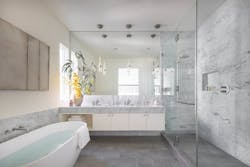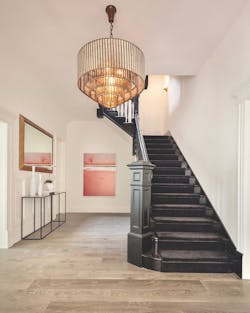Q&A: Form and Feng Shui
Joanna Lily Wong is the founder and principal of Ennate Design and Development in the San Francisco Bay Area. After a career in fashion, Wong worked in remodeling before jumping into residential design. She now designs multimillion-dollar projects in the Bay Area.
Joanna Lily Wong Founder, Ennate
Custom Builder: How did you get into residential design?
Joanna Lily Wong: When I was a kid, I used to take paper and sketch out floor plans, using bushes as walls, and I would have a place for my cat to hang out with me in these forts.
So I’ve always been into spatial planning. I started out casually renovating in New York City doing a few kitchen remodels and cosmetic renovations. Then when I moved
to San Francisco, my goal was to open a boutique hotel. I was just really into the idea of creating beautiful spaces and environments for people. I’ve always been able to walk into a space, close my eyes, and see different options and layouts flying around in my head ... to be able to see nothing and turn it into something.
CB: You’ve worked on some really high-budget projects. Where should a builder spend the most on a home?
JLW: Kitchens! I think of the kitchen as the mouth of the home. It’s how the home is going to communicate to the world. Everybody has an opinion on kitchens and cares what their kitchen looks like. It’s where we spend so much of our time, and even when we have parties, people convene there. One tip is to get the best appliances you can afford. People may not know the difference between countertop materials, but they can read a label, and consumers do identify with certain brands. Also, kitchens are difficult to renovate. If a homeowner is living in the space, it’s a big pain to redo the kitchen because it’s so disruptive to the daily schedule. So it’s better to just get it right when you’re building the home.
Wong employs feng shui principles to instill a sense of balance in her designs, such as this Pacific Heights home in San Francisco.
CB: How do you balance creating a custom, unique look while also checking off those Pinterest-inspired details people expect?
JLW: Well, I think it’s important to listen and really ask questions because sometimes people don’t realize that what they really like in that Pinterest photo is the morning light. They haven’t really thought about what exactly it is they like. So I take elements of the photo, and I ask clients what exactly they’re attracted to. Everybody has something a little funky they like, too ... something that may be off to others. I’m all about going with a client’s personal style. I never have a one-size-fits-all approach. Having a client is having a relationship, and you should be able to create a unique home for them. For example, if I know that somebody loves to travel and go on safaris, then I want to bring some
elements of that into the home, so when they see it
and they feel it, they have those same positive feelings.
It’s a bit of psychology.
CB: What role do marketing and social media play in
your business?
JLW: I started my Instagram (joannalilywong) because I had so much knowledge spilling out of me and I needed it to go somewhere. Friends were always reaching out to me for advice. I would advise them and then think, ‘That’s a tip other people would benefit from.’ Knowledge is power. Nowadays everything is so accessible to everyone. I don’t think I need to keep my design secrets close to me, and I really want everybody to benefit. I don’t do any other marketing other than my social media, but it does bring in clients. I’m always pleasantly surprised by how far a reach it can have. And it’s also a useful tool for me to represent what I do and how I think. It’s hard to relay that through a website or through a 30-minute meet and greet.
CB: How has your former career in fashion influenced your home designs? Are there any synergies?
JLW: I do notice that they tend to be similar, but interior design is a little bit slower to catch on, as redesigning a whole house takes much longer than producing a piece of clothing. But there are trends I’ve seen that align, like, for example, rose gold was really big in jewelry, and eventually I started seeing it in plumbing fixtures. I thought that was really cool.
For Wong, luxury doesn’t require a lot of space, as is evident in this high-end home on a narrow lot in San Fransisco’s Noe Valley.
CB: San Francisco is pretty cramped for space. How do you balance that issue with creating a luxury design?
JLW: It’s all about materials and quality. In San Francisco, lots are generally only 25 feet wide, so we are really tight, but to me, luxury has nothing to do with the amount of space. If you look at a New York or Paris apartment, the spaces there are even smaller than what we have in the Bay Area, but nobody would say Paris is lacking in luxurious interior design. You could have a 500-square-foot studio that feels more luxurious than a 10,000-square-foot house because of the materials chosen.
CB: Can you talk a bit about how your identity affected the way you approach design?
JLW: This isn’t to say that every man is like this or every woman is always like that, but I’ve observed and listened to a lot of homebuyers and homeowners. I love beautiful design, but in a home, it’s useless unless it functions well. It may not be this way in every household, but in many homes, the wife still does most of the cooking and cleaning. That’s a lot of work, and I have empathy for them. I want to make homes that make these chores as easy as possible. Women want a place to set their groceries down when they come in from the garage. They want a place to tuck their kids’ shoes away near the entryway. They want to be able to watch kids in the yard from the kitchen. I don’t care how beautiful black floors can be. They collect dust like crazy, and unless you have a maid every day, forget it. Although I work in the luxury field, I’m always very practical.
CB: How does feng shui relate to home building?
JLW: Functionally, it helps with everything from floor plans to choosing finishes. It helps with the flow of the home. It creates energetic or cozy spaces, or whatever energy you want to create in a certain room. I think the goal of creating a home for anyone is that you want it to be a healthy, happy place. And that’s exactly what feng shui does when you incorporate it. A lot of designers use feng shui principles without even realizing.
CB: Why did you start employing those principles in
your designs?
JLW: I’m Chinese, and feng shui is Chinese, so it has always been a thing that existed for me. My parents would refer to it, but I never really dove super deep into it. Then, at one point, I had a house I was really worried about. It was a spec house I’d developed and it was slow to sell. People would come in and say they loved the house, but I just wasn’t getting any offers. I was starting to get really stressed out about it, so I actually looked into feng shui and tweaked some things, like the home’s spatial planning. A week later, I got an offer over list price and sold the home. After that, I thought, “I’m really gonna look into this.”
When you have that foundation of feng shui knowledge, you just organically start incorporating it into your design. For a lot of clients who hire a designer, they then have to hire a separate feng shui consultant. And then those two people have to work together. I’m just one person, and it all works together organically with me.
CB: What’s your process and how has it changed
over time?
JLW: I’ve really embraced the role of designer. I have always had a role in designing my development projects, but
as time went on, I found it easier and more fun to handle more aspects. Now I’m doing all of it. I’ve learned to
go with my gut, and that really feels great. I’m not looking around at what other developers or designers are doing but am creating my own identity and paving my own unique path.



